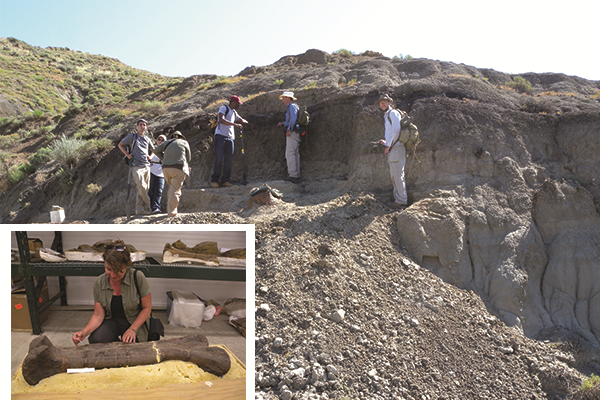Mesozoic Mass-Extinction Events and Perturbations in the Carbon Cycle

Fieldwork in North Dakota where we study the effects of an asteroid impact 66 million years ago. Corner picture: Vivi Vajda with Triceratops thigh bone.
Summary
This multidisciplinary study examines the evolution of Earth through deep geological time. It targets the patterns and causes of major global environmental perturbations and the relationships between changes in the carbon cycle and climate.
This project aims to determine the plant turnover rate (extinction and recovery) across the Cretaceous-Paleogene event, when an asteroid struck the Earth, 66 million years ago. The extinction at the Cretaceous-Paleogene boundary provides a tool to interpret other less well resolved mass-extinction events, such as the Permian-Triassic and Triassic-Jurassic events.
We apply palynology, geochemistry (carbon isotopes), sedimentology and zircon dating on targeted successions. Presently we are working on vast successions spanning the Triassic-Jurassic boundary in New Zealand, China and Australia.
The project further includes the international IGCP project 632 (see Affiliates) aiming at correlating major Jurassic biological events by comparing vegetation changes between the two hemispheres. The main tools used are palynology, sedimentology and geochemistry. The sites of study have a global coverage including Sweden, New Zealand, Australia and China.
This research is funded by the Swedish Research Council (VR) and UNESCO-IUGS
External Project Participants
Nanjing Institute of Paleontology, China
University of Kiev, Ukraine
Affilliates
LUCCI , http://www.lucci.lu.se/ ; IGCP632
; IGCP632
Selected Publications
Steinthorsdottir, M., Vajda, V., Pole, M., 2016. Global trends of pCO2 across the Cretaceous-Paleogene boundary supported by the first Southern Hemisphere stomatal proxy-based pCO2 reconstruction. Palaeogeography, Palaeoclimatology, Palaeoecology 464:143-152.
Vajda, V., Pesquero Fernández, D., Villanueva-Amadoz, U., Lehsten, V., Alcalá, L., 2016. Dietary and environmental implications of Early Cretaceous predatory dinosaur coprolites from Teruel, Spain. Palaeogeography, Palaeoclimatology, Palaeoecology. 464: 134–142.
Vajda, V., Linderson, H. & Mcloughlin, S., 2016. Disrupted vegetation as a response to Jurassic volcanism in southern Sweden. ories. Geological Society, London, Special Publications, 434: 127 –148.
Sha, J., Olsen, P.E., Yanhong Pan, Y., Xu, D., Wang Y., Zhang, X. & Vajda, V. 2015. Triassic-Jurassic climate in continental high-latitude Asia was dominated by obliquity-paced variations (Junggar Basin, Urumqi, China), PNAS 112: 3624–3629.
Vajda, V. & Bercovici, A., 2014. The global vegetation pattern across the Cretaceous-Paleogene mass-extinction interval – an integrated global perspective. Global and Planetary Change 12: 29–49.
Vajda, V., Calner, M. & Ahlberg, A., 2013. Palynostratigraphy of dinosaur footprint-bearing deposits from the Triassic– Jurassic boundary interval of Sweden. GFF – A Scandinavian Journal of Earth Sciences 135: 120–130.
Vajda, V. & Raine, J.I., 2010. A palynological investigation of plesiosaur-bearing rocks from the Upper Cretaceous Tahora Formation, Mangahouanga, New Zealand. Alcheringa 34: 359–374.
Vajda, V. & McLoughlin, S., 2004. Fungal Proliferation at the Cretaceous-Tertiary Boundary. Science 303: 1489.
Vajda, V., Raine, I.J & Hollis, C., 2001. Indication of Global deforestation at the Cretaceous-Tertiary Boundary by New Zealand Fernspike. Science 294: 1700–1702.


